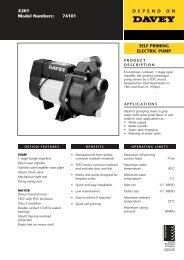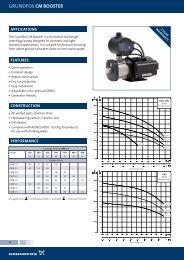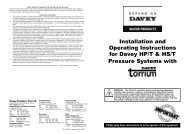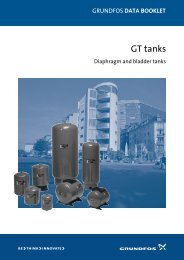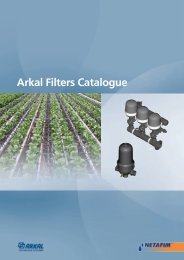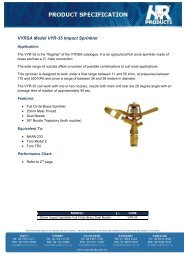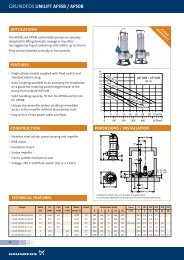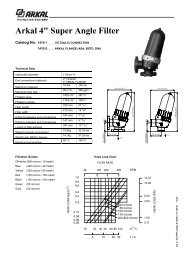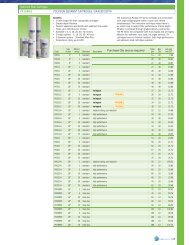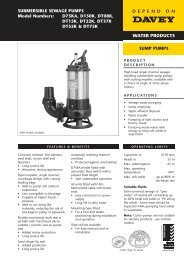What is Drip Irrigation? - Dural Irrigation
What is Drip Irrigation? - Dural Irrigation
What is Drip Irrigation? - Dural Irrigation
Create successful ePaper yourself
Turn your PDF publications into a flip-book with our unique Google optimized e-Paper software.
<strong>What</strong> <strong>is</strong> <strong>Drip</strong> <strong>Irrigation</strong><br />
<strong>Drip</strong> <strong>Irrigation</strong> <strong>is</strong> generally recogn<strong>is</strong>ed as the most efficient method of irrigating. While<br />
sprinkler systems are around 75-85% efficient, drip systems typically are 90% or higher.<br />
<strong>What</strong> that means <strong>is</strong> much less wasted water! <strong>Drip</strong> irrigation systems do not suffer from<br />
overspray onto paths and driveways and they do not lose water due to m<strong>is</strong>ting and<br />
evaporation. For these reasons drip irrigation <strong>is</strong> the preferred method of water d<strong>is</strong>tribution<br />
by almost all water authorities in Australia and <strong>is</strong>, in fact, the only method exempt from<br />
water restrictions in Sydney.<br />
<strong>Drip</strong> <strong>Irrigation</strong> saves water, saves money, <strong>is</strong> easy to install, easy to design, and keeps your<br />
garden healthy.<br />
<strong>Drip</strong> <strong>Irrigation</strong> works by applying water slowly, directly to the soil. Th<strong>is</strong> means that the<br />
water soaks into the soil before it can evaporate or run off and that the water <strong>is</strong> only<br />
applied where it <strong>is</strong> needed; at the plant's roots, rather than sprayed onto the foliage.<br />
The most common method of <strong>Drip</strong> <strong>Irrigation</strong> <strong>is</strong> the use of what <strong>is</strong> generally referred to as<br />
Inline <strong>Drip</strong> or <strong>Drip</strong>line. The <strong>Drip</strong>line sold by <strong>Dural</strong> <strong>Irrigation</strong> <strong>is</strong> developed and<br />
manufactured by Netafim. It <strong>is</strong> high quality poly tubing with self-contained drippers<br />
welded into the interior wall set at regular intervals.<br />
<strong>Drip</strong>line comes with either non-pressure compensated drippers (Mini-Scape and Scapeline)<br />
suitable for use on, more or less level surfaces or with pressure compensated drippers<br />
(Techline) suitable for slopping areas.<br />
Non-Compensating dripline drippers will produce a uniform flow rate provided that the<br />
change in elevation across the watering zone <strong>is</strong> not more than 1.5 metres. The drippers<br />
which use turbulent water passages to force the water through a labyrinth provide greater<br />
turbulence and highly accurate flow rates thus preventing suspended solids from settling at<br />
the bottom of the labyrinth and consequently clogging it.<br />
Pressure Compensated drippers are constructed with wide water passages based on a<br />
labyrinth and a free floating diaphragm designed to regulate the volume of water.<br />
The diaphragm <strong>is</strong> activated by the continual differential pressure created by the labyrinth,<br />
thus maintaining constant dripper flow over a wide pressure range. Any particles which<br />
might cause clogging will either be flushed out through the wide water passages, or<br />
increase the pressure differential, causing the diaphragm to momentarily increase the crosssection<br />
volume for outgoing water and flush the dirt out of the system. Pressure<br />
Compensated <strong>Drip</strong> lines d<strong>is</strong>charge the same amount of water under a wide pressure range,<br />
providing high uniformity.
<strong>What</strong> Type of <strong>Drip</strong>line Should I Use<br />
<strong>Dural</strong> <strong>Irrigation</strong> carries three Netafim <strong>Drip</strong>lines:<br />
• Mini-Scape<br />
Mini-Scape <strong>is</strong> a spaghetti tube style of dripline with non-pressure compensated drip<br />
emitters spaced at either 150mm or 300mm. Each emitter drips at 1.9 litres per hour. Th<strong>is</strong><br />
product <strong>is</strong> suitable for surfaces with a change in elevation of no more than 1.5 metres. The<br />
300mm spacing has a maximum run length of 15 metres and the 150mm spacing has a<br />
maximum run length of 8 metres.<br />
Min<strong>is</strong>cape <strong>is</strong> great in new installations but its true staring role <strong>is</strong> the ease with which it can<br />
be used for converting spray systems to drip.<br />
• Scapeline<br />
Scapeline uses the same style of built in non-pressure compensated dripper as Mini-Scape<br />
but the tube <strong>is</strong> a standard 13mm poly pipe. The larger diameter pipe allows it to be run out<br />
in lengths of up to 45 metres. The drip emitters are spaced at either 300mm or 400mm and<br />
each dripper delivers 2 litres per hour. Th<strong>is</strong> product, like Mini-Scape, <strong>is</strong> suitable for<br />
surfaces with no more than a 1.5 metre change in elevation.<br />
Scapeline <strong>is</strong> also suitable for converting ex<strong>is</strong>ting spray systems to <strong>Drip</strong> as well as new<br />
installations using standard 13mm poly fittings connections.<br />
• Techline<br />
Techline uses a pressure compensated dripper different from Scapeline and Mini-Scape.<br />
The tube <strong>is</strong> a standard 13mm poly pipe but the dripper used in allows the product to be<br />
used on a sloping or terraced block without a variation in the flow rate across the change in<br />
elevation. The drip emitters are spaced at either 300mm or 400mm and each dripper drips<br />
at 2.3 litres per hour. It can also be used under higher pressure and the maximum run<br />
lengths increased to 75 metres.<br />
Techline <strong>is</strong> suitable for converting ex<strong>is</strong>ting systems as well as new installations. It <strong>is</strong><br />
connected using standard 13mm poly fittings.
How do I install it<br />
While drip systems are simple to design and install, there are some basic guidelines to<br />
follow that will ass<strong>is</strong>t your drip system to work at its most efficient.<br />
The soil type dictates how far apart each run of <strong>Drip</strong> line should be installed and therefore<br />
how much <strong>Drip</strong> line <strong>is</strong> necessary for each site. If the spacing of the <strong>Drip</strong> line <strong>is</strong> wrong the<br />
system will not work at its most efficient. Once the correct spacing has been decided the<br />
meterage can either be paced out on site or if a scale drawing <strong>is</strong> available the meterage can<br />
be worked out very quickly from the square meterage of the gardens. It <strong>is</strong> crucial that you<br />
determine what type of soil you have before you decide which product <strong>is</strong> best for you. As<br />
an example the standard spacing for installation of Techline, Scapeline and Mini-Scape <strong>is</strong><br />
400mm, but:<br />
1. If the your garden beds are sandy the water will drain straight down and th<strong>is</strong> will mean<br />
that you need to install the runs length of drip line closer together at around 300mm.<br />
2. If your gardens have high clay content the water will remain closer to the surface and<br />
the runs could be spaced out at 500mm.<br />
<strong>Drip</strong> line <strong>is</strong> best installed in a grid pattern that includes a header and collector pipe in<br />
19mm poly pipe. Th<strong>is</strong> will provide the most efficient system as well as providing the best<br />
locations to install air release and flush valves. If a system gets a break in it and the <strong>Drip</strong><br />
line includes a dead end there <strong>is</strong> a good chance that that <strong>is</strong> where the soil will end up and<br />
th<strong>is</strong> means that there will be a blocked dripper at some stage.<br />
If it <strong>is</strong> difficult to install the system in a grid pattern due to the garden being heavily<br />
planted and establ<strong>is</strong>hed, <strong>Drip</strong> line can be snaked though the garden in order to supply an<br />
adequate amount of water to the area. It <strong>is</strong> important to note that it <strong>is</strong> not necessary to have<br />
a dripper at the base of each plant. The plants roots are not all underneath the base of the<br />
plant they spread out so it <strong>is</strong> more important to apply an even amount of water the whole<br />
garden area than try to water each individual plant.
Follow these guides<br />
Large gardens<br />
These areas are best watered in a grid pattern with a collector pipe at each end. Th<strong>is</strong> will<br />
ensure an even flow of water to all the drippers and help prevent a blocked dripper in the<br />
event of a break in the line.<br />
Formal hedges or straight plantings<br />
In these situations a single run of the appropriate product installed on each side of the<br />
hedge will do the job. If the area <strong>is</strong> more or less level and the runs are short Scapeline or<br />
Mini-Scapeline can be used.<br />
Boundary trees or shrubs<br />
Where certain trees or shrubs need more water than the surrounding area a lateral line can<br />
be installed with a ring of the appropriate dripline product installed around each individual<br />
plant.<br />
<strong>What</strong> Accessories do I need for a drip system<br />
It <strong>is</strong> worth noting that with drip systems the accessories can be viewed as insurance for the<br />
system. If you plan on irrigating a complete residence with drip then filters, pressure<br />
reduction valves, air release and flush valves are essential. However, if it <strong>is</strong> only being<br />
used to irrigate a small garden bed then its overkill to outlay $120 on protection for $30<br />
worth of product in th<strong>is</strong> case a cheaper filter/pressure reduction valve (as pictured) and an<br />
air release valve might be all you need.<br />
Backflow Prevention Valve<br />
A Backflow Prevention Valve prevents back siphoning of nonpotable<br />
water into the water supply and come in a range of<br />
varieties. All water authorities require backflow prevention<br />
devices to be used on all fixed irrigation systems. You should<br />
consult your local water authority to find out which one <strong>is</strong><br />
required for your proposed system. Generally, most domestic<br />
watering systems require a Dual Check valve but if you are<br />
installing a Techfilter or applying fertil<strong>is</strong>er through your<br />
irrigation lines then you will probably be required to install a<br />
Reduced Pressure Zone device. Backflow Prevention valves<br />
are the first item in your line after your faucet.
Filter<br />
You must use a filter. <strong>Drip</strong> emitters have very small openings that can become clogged.<br />
City water <strong>is</strong> not free from particles that will clog your drip emitters! There are two basic<br />
filter options (d<strong>is</strong>c and basket) and which filter used depends on how much <strong>Drip</strong> line <strong>is</strong><br />
being protected.<br />
A basket filter can be used for small gardens with up to 50 metres of <strong>Drip</strong> line however any<br />
more <strong>Drip</strong> line it <strong>is</strong> recommended that a d<strong>is</strong>c filter <strong>is</strong> used. For larger areas use at least a<br />
120 mesh d<strong>is</strong>c filter which should be installed after the backflow valve and before the<br />
pressure reduction valve.<br />
There <strong>is</strong> also a Techfilter available that <strong>is</strong> used in sub-surface dripline installations. Th<strong>is</strong><br />
filter has a root retardant in it to protect your drip emitters from root intrusion and the<br />
cartridge needs to be replaced every 2 years.<br />
Pressure Reduction Valve<br />
If you are coming off a mains water supply you must use a Pressure Reduction Valve<br />
(PRV). <strong>Drip</strong>line <strong>is</strong> intentionally made from weak walled poly pipe so that <strong>is</strong> extremely<br />
flexible for ease of installation. A PRV must be installed to reduce the pressure inside the<br />
<strong>Drip</strong>line. Th<strong>is</strong> pressure needs to be between 10 and 30 psi. There are a few options but th<strong>is</strong><br />
time it <strong>is</strong> the flow rate and the amount of drip line being used that dictates which unit<br />
should be used. The PRV <strong>is</strong> installed after the filter and after the solenoid valves in an<br />
automatic system.<br />
Air Release Valves<br />
These valves are essential protection for the system. An air valve<br />
should be installed at the highest point of the system, th<strong>is</strong> <strong>is</strong> to allow<br />
air into the system once it <strong>is</strong> turned off.<br />
Th<strong>is</strong> prevents the drippers from sucking in air and<br />
possibly soil particles when the system <strong>is</strong> turned off<br />
and the water in the system drains out through the<br />
lowest point.<br />
Flush Valves<br />
A flush valve should be installed at the lowest point of the<br />
system, th<strong>is</strong> <strong>is</strong> to allow any rubb<strong>is</strong>h that may have made its<br />
way into the system out without blocking up the drippers. Its<br />
worth noting that the flush valve lets about 2 litres of water<br />
out each time the system turns on and so a gravel pit installed<br />
under it <strong>is</strong> adv<strong>is</strong>able.
Wire Pegs<br />
All of the different types of <strong>Drip</strong> line should be staked at<br />
least every 2 metres to prevent the pipe from r<strong>is</strong>ing up<br />
through your mulch. The pipe will expand and contract with<br />
changing temperature which will push it up through the<br />
mulch if it <strong>is</strong> not staked down.<br />
Adapters and Fittings<br />
These fittings are used to connect the <strong>Drip</strong>line to the lateral<br />
lines. It <strong>is</strong> important to make sure the fittings are the right<br />
size! Using fittings made for a different tubing size will<br />
result in the fitting blowing out of the tube.<br />
You can now go ahead and design and install an efficient drip irrigation<br />
system and more importantly gain maximum enjoyment from your garden.
Filename: <strong>Drip</strong> irrigation tutorial.doc<br />
Directory: \\DOMAIN-SERVER\Users\Donna Davey\My<br />
Documents\Webdocs\<strong>Drip</strong> <strong>Irrigation</strong><br />
Template: C:\Documents and Settings\Donna<br />
Davey\Application Data\Microsoft\Templates\Normal.dot<br />
Title:<br />
<strong>Drip</strong> irrigation <strong>is</strong> the most efficient method of<br />
irrigating<br />
Subject:<br />
Author:<br />
Donna Davey<br />
Keywords:<br />
Comments:<br />
Creation Date: 1/20/2005 3:21 PM<br />
Change Number: 2<br />
Last Saved On: 1/20/2005 3:21 PM<br />
Last Saved By: Donna Davey<br />
Total Editing Time: 1 Minute<br />
Last Printed On: 1/27/2005 10:32 AM<br />
As of Last Complete Printing<br />
Number of Pages: 6<br />
Number of Words: 1,721 (approx.)<br />
Number of Characters: 9,813 (approx.)




